Among the hot topics for discussion these days is the 380 ACP cartridge, more than one hundred years old and among the first of the modern smallbore pistol cartridges. Both the 38 ACP and the 32 ACP predate the 380, and each as originally introduced featured a small semi-rim for headspace. The 380 headspaces in modern fashion on the case mouth. Originally intended to perform as a pocket-pistol cartridge in early Colt and Browning pistols, the 380 Automatic Colt Pistol cartridge has enjoyed increasing popularity with the passage of reasonable concealed carry laws. Lightweight pocket pistols are the rage, and the 32 ACP and 380 ACP are popular numbers. The race to produce a maximum size savings in 380 ACP pistols has produced pistols in this caliber no larger than the equivalent 32 ACP chambering.
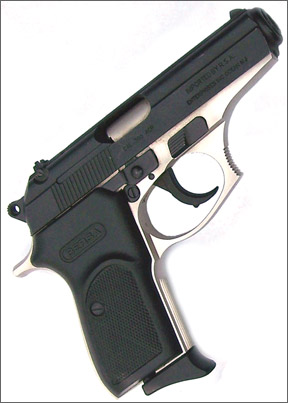
The modern self-loading pocket pistol as we know it first came to be popular with the introduction of very well-made pistols around 1900. Browning, Colt, Dreyse, and Walther are among the better known names. The pocket pistol was designed to offer some measure of protection against thugs, robbers, muggers and the French “Apache.” Their value was as much in threat as in potency. No one wants to get shot, especially with the complications of showing up at the hospital and explaining the wound. While the power of the pocket pistol is not impressive, any number of citizens, criminals and cops have been killed or crippled by these pistols. Then and now, some of the pistols are well made of good material and offer good function and reliability. It is also true that very poor designs and lax quality control are found among these pistols as well.
A recent question we fielded was ammunition choice for the 380 ACP. A very experienced reader was concerned with penetration. If the JHP would not be counted on for penetration, he asked, would he be better off to load the pistol with full-metal-jacket ammunition? He wondered as to the effectiveness of the 380 ACP, although he mentioned that it would do for “cranial shots.” If the bullet cannot be counted on to reach the vitals, then it would hardly be of much use even if it did expand. However, FMJ loads do not necessarily solve every problem. It is not well known, but a lightweight FMJ bullet is far more likely to stop short in penetration than a heavier bullet of moderate velocity. The smallbore bullets are also more likely to skid off bone. Often a heavier-for-the-caliber-bullet will penetrate more even at lower velocity. One of our raters has the distinction of having shot more vehicles than anyone else we are aware of. He has noted that the 9mm Luger 124-grain bullet penetrates more than the 115-grain load, even though the 124-grain bullet is slower. The 45 ACP 185-grain FMJ bullet does not penetrate as well as the 230-grain FMJ as a rule, even when loaded to higher velocity. A lighter bullet seems to be more easily turned. Even loading a full-metal-jacketed bullet in the 380 ACP is no guarantee of full penetration in a heavy jacket or to the vitals of a heavily muscled individual, as seen in the test table nearby.

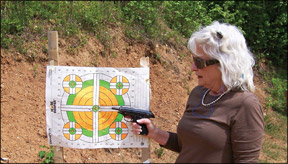
In this test program our goal was to present the results and let the reader make up his or her own mind. However, none of the JHP loads met our criteria for a defense load. While the reader may make allowances in his or her own mind for the fact that these are pocket-pistol caliber loadings, the threat you face will be the same no matter what type of handgun you may be armed with. The 380 you carry to dissuade an unarmed strong-arm panhandler may save you that day, but on another day you may be faced with a 280-pound example of our protein-fed ex-con criminal class who has boosted a Glock and intends to take what you have, be it a vehicle, spouse, or money. This is not a pretty sight to face with a pocket pistol.
Overall, our recommendation is to deploy at least a 9mm Luger or 38 Special-caliber handgun. In our experience, modern shooters tend to look at the 380 as a lighter alternative to the 9mm. In terms of reality and the best choices, the obvious comparison is between the 38 Special snubnose and the 380. As a point of reference, we included our results with a middle of the road 125-grain JHP 38 Special +P load fired from a 2-inch-barrel revolver. There are faster and slower 38s, but the Remington 125-grain +P was available and represents an average for performance with the 125-grain JHP. This is out of the norm for a caliber comparison, but it makes a striking example of the difference of what we deem is the marginal 380 and the adequate 38 Special.
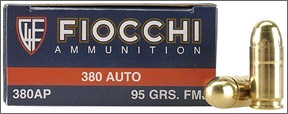
If you already have the 380, of course, you are not interested in 38 Special performance. Rather, you still want to know which load will perform the best in your 380 ACP pistol. In the end, several of the loads gave consistent performance and a percentage expanded aggressively. We were surprised that the FMJ load penetrated less than 14 inches in water. With a light bullet and small caliber at modest velocity, we should not be surprised. If you deploy a 380 ACP pistol, we believe that the best choice is a FMJ load to ensure proper penetration in more-but not all-the situations in which a JHP might fail.
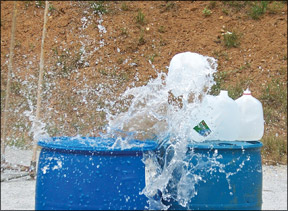
Test Setup
We fired horizontally into gallon jugs at 10 feet. The jugs are 6 inches deep, so measuring penetration was a simple thing if the bullet penetrates at least two jugs. Often the bullet barely penetrated the third or was found resting in place at the bottom of the jug, allowing interpretation of the distance traveled.
We tested these loads in a Bersa 380 ACP, the personal pistol of one of our raters. These pistols are usually reliable and represent a reasonable choice in the caliber. The accuracy cannot be faulted, and there were no failures to feed, chamber, fire, or eject, nor has this pistol ever experienced a problem of any kind. While there are smaller pistols available, the accuracy section of the test demanded a pistol of sufficient size to make accuracy testing viable as a comparison of the loadings. Accuracy was conducted at 15 yards in respect to the limitations of the caliber. While smaller and lighter 380s are available, the Bersa is an easy pistol to use well and an easy pistol to like with no bad traits or sharp edges. The action was smoother than some more expensive pistols.
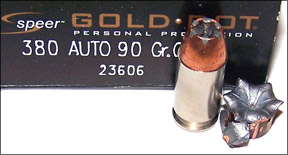
Heres what we thought of teach load.
Fiocchi FMJ 95-grain No. 380FMJB, $22.50/20
We learned that 50 non-expanding bullets may be had for the price of 20 hollowpoint bullets, on average. While any load would have sufficed as a test for FMJ loads, Fiocchi is usually a little faster than most and often produces good accuracy. However, we were surprised. The 9mm ball and 45 ball produces up to 30 inches of penetration in gelatin. Some feel that water is harder on bullets and that water will make bullets separate that will not separate in gelatin. However, 14 inches is short penetration for a 9mm/38 nonexpanding load. Just the same, this is a recommended load for personal defense. Several of our raters would load this one and hope for the best.
Our Team Said: When all the myriad possibilities of attack are considered, we recommend carrying FMJ loads in the minor calibers to ensure adequate penetration.
Speer Gold Dot 90-gr. No. 23606, $17.99/20
The Gold Dot is an extraordinary bullet design well suited to most calibers. We were surprised to find the Gold Dot, Hydra-Shok, and PMC so close in ballistic performance. With an average velocity of 936 fps, the Gold Dot penetrated to exactly the same average
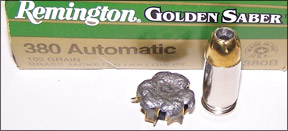
depth as the Hydra-Shok. It is an even bet that ATK engineers set the parameters for both Federal and Speer. There was little to separate the Hydra-Shok and the Gold Dot, with the Gold Dot petals beings pushed back over the mushroom. However, even though water is hard on any bullet, the Gold Dot held together with excellent weight retention. especially when the lower average price is considered. When all things are considered, the Speer 90-grain Gold Dot had as much penetration or more than any other JHP, more expansion by a margin than the bullets with adequate expansion, excellent accuracy, and a clean powder burn.
Our Team Said: The Hydra-Shok outperformed the Starfire, and careful examination showed that the Gold Dot outperformed the Hydra-Shok, making it a Best Buy.
Federal Hydra-Shok 90-gr. No. PD380HS1H, $26.95/20
This was the most expensive round tested. The box containing these Hydra-Shok rounds read “reduced recoil.” Yet this was the fastest load tested, with an average of 960 fps and the only loading to break 1000 fps with some examples. Accuracy was excellent.
Our Team Said: Ballistic performance was more or less close to the Starfire and the Gold Dot, with slightly more travel in the third jug than the Starfire. The Hydra-Shok was the most accurate loading tested.
Remington Golden Saber 102-gr. No. GS380B, $21.18/25
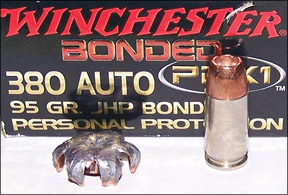
The Remington box holds 25 rather than the 20 rounds in each of the others, making it a true half-box of ammunition compared to a 50-round cartridge box, and offsetting the total price somewhat. Expansion was superior and consistent. The Golden Saber had the highest momentum, or power factor, but was only slightly more noticeable in recoil. We had the impression the momentum of the Remington bullet produced more aggressive, sure cycling, but none of the cartridges of any of the makes tested malfunctioned in any way. The Remington load averaged 910 fps.
Our Team Said: We had high hopes for the heaviest bullet tested, and most of us assumed it would penetrate to the greatest depth. We were wrong. The Golden Saber was squarely behind three loads we tested in penetration.
Winchester SXT 95-gr. No. S380PDB, $15.99/20
Pricewise, the Winchester load is affordable for a premium loading, and it was impressive on several counts. The Standard Deviation was so low we rechecked our chronograph. We actually had several individual cartridges record exactly the same velocity-a rare performance. Accuracy was excellent, with a full powder burn. Expansion was impressive, looking more like a 9mm than a 380. But penetration was in the low range, calibrating to about 8 inches in gelatin.
Our Team Said: We are certain some will choose the Winchester Bonded Core loading based on this superior expansion, but we are leery of any load producing this low level of penetration.
PMC Starfire 95-gr. No. 380SFA, $12.85/20
This was the least expensive loading by a considerable margin.
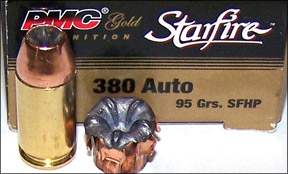
The PMC load was accurate enough for personal defense, although we prefer better accuracy. There were no malfunctions. The Starfire was the slowest load tested. It was pleasant to fire, however. After just completing a test of 9mm ammunition, we were completely unimpressed with the damage done to the plastic water jugs we used. The 9mm had thrown jugs off of the table and produced a cascade of water. The 380 barely moved the jugs. The Starfire round penetrated two full jugs and barely entered the third, giving it a rating of 13 inches, which is closer to 10 inches in ballistic gelatin.
Our Team Said: Expansion was good, considering the relatively low velocity. The Starfire was the least accurate round tested.


























